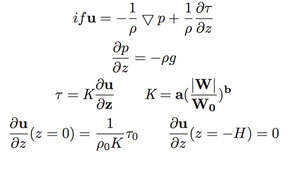OSCAR surface currents are calculated from satellite datasets using a simplified physical model of an upper ocean turbulent mixed layer. The total velocity is comprised of a geostrophic term, a wind-driven term, and a thermal wind adjustment. The OSCAR model assumes quasi-steady linear flow in a surface layer with turbulent mixing parameterized by an eddy viscosity. Wind stress is related to shear via the eddy viscosity. The geostrophic term is computed from the gradient of sea surface height (SSH) fields and there is a contribution to vertical shear from horizontal sea surface temperature (SST) gradients through the thermal wind relation. OSCAR is an analytical solution to the simplified momentum equation using Stommel boundary conditions – shear goes to zero at depth. The eddy viscosity is constant in depth but depends on wind. The currents are provided as an averaged value over the top 30m of the solution. Over the years, the OSCAR project has evolved from a tropical study [1] to a global near-real-time product [2]. The equations for the basic OSCAR model are:
where: u=u+iv, τ0 is surface wind stress, H=125m, and K is a vertical eddy viscosity, calculated as a function of wind. Optimal choices for a and b are based on a regression against drifter climatology and blend from a=8×10-5 m2s-1, b=2.2 at the equator as in [3], to a=2.85×10-4 m2s-1, b=2 for the global value.
OSCAR is an ongoing research project intended to improve the calculation of surface currents from satellite data, and validation methods. The quasi-steady calculation has been proven to be successful for steady winds and on basin-wide scales. However, to capture small-scale wind-driven surface currents, unsteady dynamics must be included in the model. Ongoing research goals are to develop the wind-driven component to include local time-dependent wind dynamics, to exploit the enhanced vector winds from multiple satellites, to incorporate vertical mixing processes, and to investigate vertical processes controlling basin-wide transport.
OSCAR has a broad user interest. For example, OSCAR has a strong user base in the boating community. The data are also in use for fishery resource management research, marine animal migrations studies, and other maritime applications. OSCAR can also be used indirectly in determining wind stress and bulk air-sea fluxes since in air-sea flux algorithms the wind stress and heat fluxes depend upon wind relative to surface flow. The OSCAR analyses have been used extensively in climate studies, such as for ocean heat storage and phytoplankton blooms. Monthly maps and anomalies are published every month in the Climate Diagnostic Bulletin, January 2001-present. They are used routinely to monitor ENSO and to test prediction models, with the surface current ENSO index typically leading the SST index by months (see ESR’s ENSO Index ). Users are encouraged to contact kdohan(at)esr.org with any use cases and publications.
[1] Lagerloef, G. S., Mitchum, G. T., Lukas, R. B. and P. P. Niiler (1999). Tropical Pacific near-surface currents estimated from altimeter, wind, and drifter data, J. Geophys. Res., 104(C10), 23,313–23,326, doi:10.1029/1999JC900197.
[2] Bonjean, F., and G. S. E. Lagerloef, 2002. Diagnostic model and analysis of the surface currents in the tropical Pacific Ocean. J. Phys. Oceanogr., vol. 32, pg. 2938-2954.
[3] Santiago-Mandujano, F., and E. Firing, 1990: Mixed-layer shear generated by wind stress in the central equatorial Pacific. J. Phys. Oceanogr., 20, 1576–1582.
Source Datasets
The source datasets used in OSCAR are level 4 gridded fields obtained from other expert centers using data collected from various satellite systems and in situ instruments. The differences between the different OSCAR v2.0 products are due to the source datasets:
OSCAR final
- SSH: SSALTO/DUACS delayed-time absolute dynamic topography (ADT) global gridded product distributed by the Copernicus Marine Environment Monitoring Service (CMEMS) and produced by the DUACS multimission altimeter data processing system. https://resources.marine.copernicus.eu/product-detail/SEALEVEL_GLO_PHY_L4_REP_OBSERVATIONS_008_047/INFORMATION
- WINDS: ERA5 10m reanalysis vector winds produced by ECMWF (Hersbach et al. 2018) downloaded from the Copernicus Climate Change Service (C3S) Climate Data Store [4].
- SST from 1993 to 2015: Canada Meteorological Center. 2012. CMC 0.2 deg global sea surface temperature analysis. Ver. 2.0. PO.DAAC, CA, USA. Dataset accessed at https://doi.org/10.5067/GHCMC-4FM02.
- SST from 2016 to present: Canada Meteorological Center. 2016. CMC 0.1 deg global sea surface temperature analysis. Ver. 3.0. PO.DAAC, CA, USA. Dataset accessed at https://doi.org/10.5067/GHCMC-4FM03
OSCAR interim
- SSH: SSALTO/DUACS near-real-time absolute dynamic topography (ADT) global gridded product distributed by the Copernicus Marine Environment Monitoring Service (CMEMS) and produced by the DUACS multimission altimeter data processing system. https://resources.marine.copernicus.eu/product-detail/SEALEVEL_GLO_PHY_L4_NRT_OBSERVATIONS_008_046/INFORMATION
- WINDS: ERA5 10m reanalysis vector winds produced by ECMWF (Hersbach et al. 2018) downloaded from the Copernicus Climate Change Service (C3S) Climate Data Store [4].
- SST: Canada Meteorological Center. 2016. CMC 0.1 deg global sea surface temperature analysis. Ver. 3.0. PO.DAAC, CA, USA. Dataset accessed at https://doi.org/10.5067/GHCMC-4FM03
OSCAR nrt
- SSH: SSALTO/DUACS near-real-time absolute dynamic topography (ADT) global gridded product distributed by the Copernicus Marine Environment Monitoring Service (CMEMS) and produced by the DUACS multimission altimeter data processing system. https://resources.marine.copernicus.eu/product-detail/SEALEVEL_GLO_PHY_L4_NRT_OBSERVATIONS_008_046/INFORMATION
- WINDS: NCEP/NCAR Reanalysis 1 10m winds from the NOAA-ESRL Physical Sciences Laboratories (PSL) analysis/forecast system data assimilation [5]. https://psl.noaa.gov/data/gridded/data.ncep.reanalysis.html.
- SST: Canada Meteorological Center. 2016. CMC 0.1 deg global sea surface temperature analysis. Ver. 3.0. PO.DAAC, CA, USA. Dataset accessed at https://doi.org/10.5067/GHCMC-4FM03
[4] Hersbach, H., Bell, B., Berrisford, P., Biavati, G., Horányi, A., Muñoz Sabater, J., Nicolas, J., Peubey, C., Radu, R., Rozum, I., Schepers, D., Simmons, A., Soci, C., Dee, D., Thépaut, J-N. (2018): ERA5 hourly data on single levels from 1979 to present. Copernicus Climate Change Service (C3S) Climate Data Store (CDS). 10.24381/cds.adbb2d47
[5] The NCEP/NCAR 40-Year Reanalysis Project: March, 1996 BAMS. https://doi.org/10.1175/1520-0477(1996)077<0437:TNYRP>2.0.CO;2

